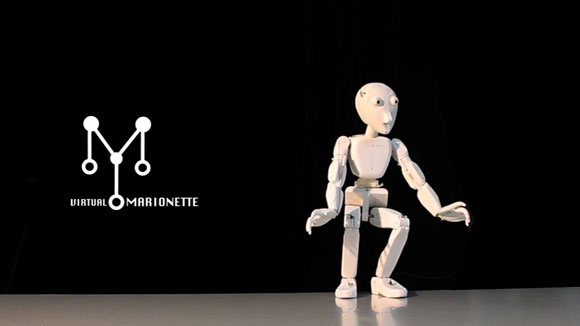VIRTUAL MARIONETTE
Virtual Marionette is a PhD research on digital puppetry that brings the art of puppetry into the world of digital animation.
Inspired in the traditional marionette our intention is to study novel interfaces as an interactive environment for creating artistic contents based on computer animated puppets. The overall goal of this project is to research and deploy methods and techniques for the manipulation of articulated puppets in real-time to define an interaction model for digital puppetry.
![]()
Video with the project overview can be found [here]
Funding
Project supported by FCT – Fundação para a Ciência e Tecnologia (Portugal)
Digital Media PhD program
UT Austin Portugal | Universidade do Porto (Faculdade de Engenharia)
Partners
IT – Instituto de Telecomunicações
DCC – Departamento de Ciências dos Computadores da FCUP – Faculdade de Ciências da Universidade do Porto
PIC – Porto Interactive Center
ESMAE – Escola Superior de Música e das Artes do Espetáculo do IPP – Instituto Politécnico do Porto
THESIS
Title: “Virtual Marionette – Interaction Model for Digital Puppetry”
Luís Leite is the author of the thesis proposal with the supervision of Prof. Veronica Orvalho from the University of Porto and co-supervision of Prof. Rui Torres from the Fernando Pessoa University.
OBJECTIVES
The outcome of this research will help to disseminate digital puppetry through new potential target users, like non-expert artists. With the interaction model the implementation of digital puppetry will become easier and intuitive based on a clear methodology. The definition of a taxonomy will help to choose and combine interaction methods and achieve immersive performance experience. Finally, we expect to develop a prototype of a virtual puppet show. A multi-user cross platform environment that combines mapping and rigging methods with digital animation techniques using multi-modal interaction, which will demonstrate the implementation of the interaction model. Through this environment, virtual marionette becomes alive presenting a creative tool to children explore live content creation, like storytelling.
METHODOLOGY
Sometimes we just want to tell a story with simple puppet animation, but then, we take so much time producing the animation that we forget the story line.
Digital puppet animation based on key-frame techniques is laborious and time consuming, especially for non-experts.
We propose to build an interaction model for digital puppetry using traditional marionette methods as a starting point. Seeking new ways for users to interact with performing objects in real-time, which can be used as a storytelling technique in educational and entertainment environments.
Traditional puppetry techniques present an intuitive interaction between the manipulator and the puppet. With digital puppetry the animation is produced in real- time focusing the improvisation of the performer making it more spontaneous, which is great for live shows and storytelling. This real-time technique presents an interactive way for working with narratives, turning story time into life.
The classic marionette model will be used as reference for building methods for the puppet interaction, because of the great advantages in handling multiple points for manipulation. Furthermore then the study of marionette mechanics the project will also seeks to highlight and recreate cultural and artistic aspects related to the marionette, like the puppet theater.
TARGET
Our main focus is the pedagogical field, developing a virtual puppet show prototype to be used as a learning tool for children. An application for storytelling that allows children explore the magical and fascinating world of puppets in a simpler and easy manner. A learning tool, that brings the creative and inventive world of puppets into the computer animation. Our intention is to measure and evaluate through experiments, how children respond to the interaction with the puppets and the success of these applications as learning tool.
A collaborative tool which let the users create their puppets (rigging, physics behavior) mapping them to any kind of interface using the interaction model.
ACNOWLEDGE
João Paulo Seara Cardoso (The Puppet Master), Veronica Orvalho (Advisor), Rui Torres (Co-Advisor), Pimenta Alves (PdH Director), Marcelo Lafontane (Puppet Master), Sérgio Rolo (Puppeteer), Rui Pedro (Puppet Creator), Nuno Correira (my Master Thesis arguer), Helena Santos and Karin Wilkins (phd methodologies Professors), Sally Jane Norman, Ben Bays, Carlos Guedes.
Institutions: FCT, IT, program UT Austin Portugal, FEUP, FCUP, ESMAE

